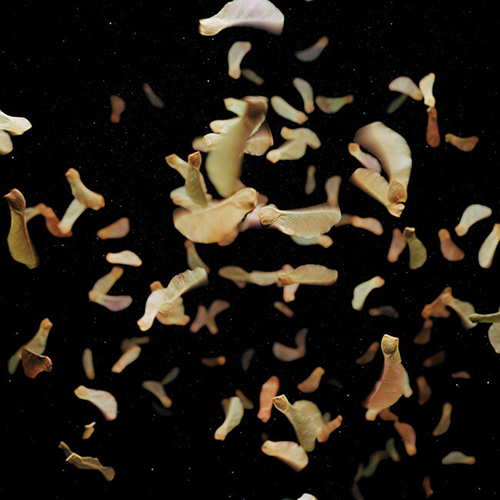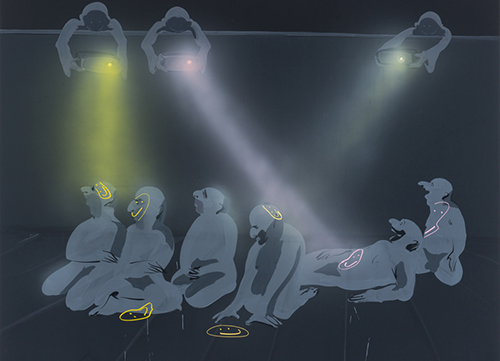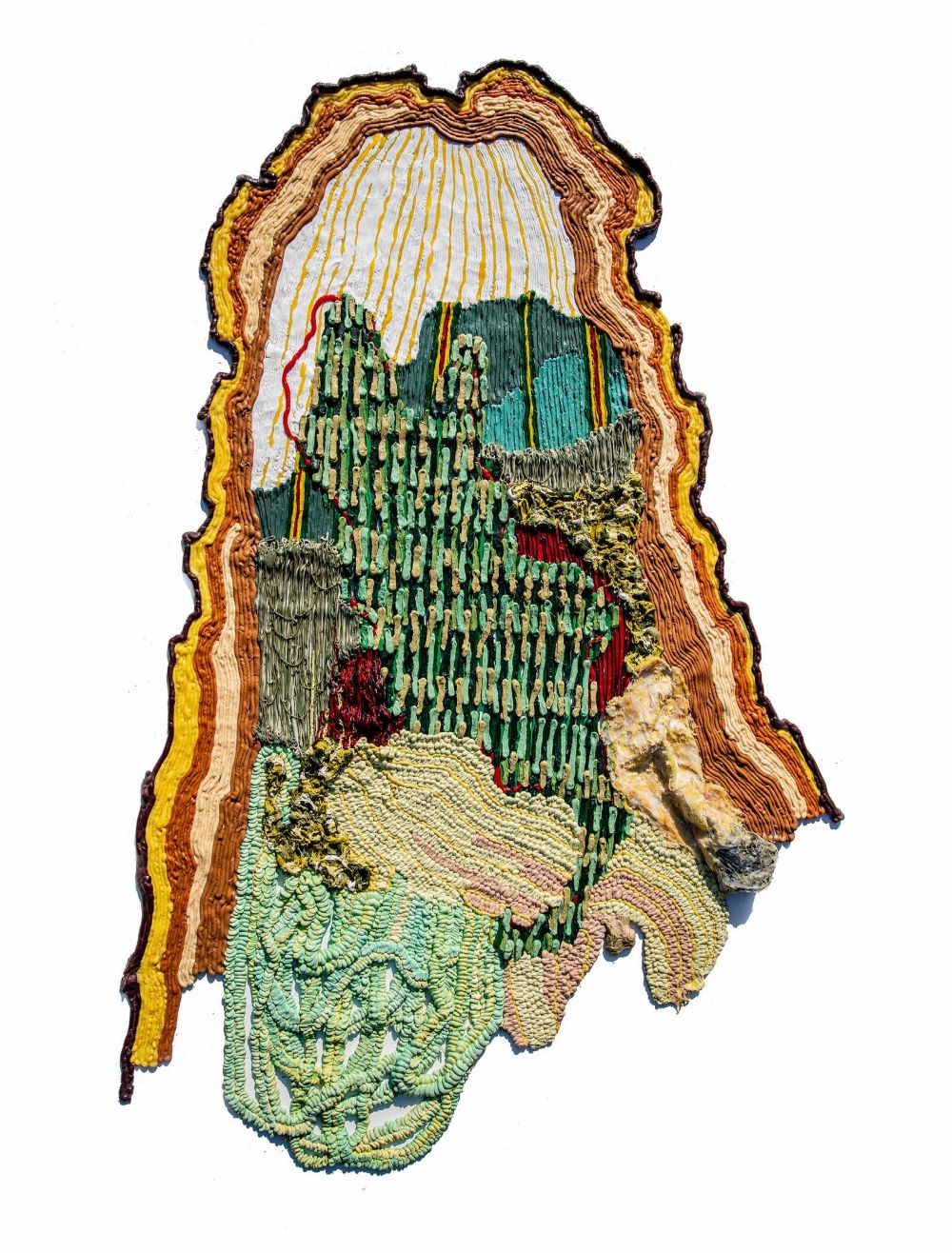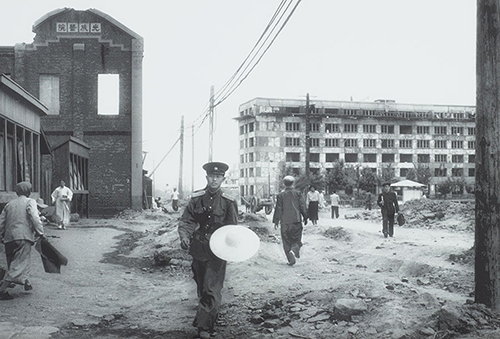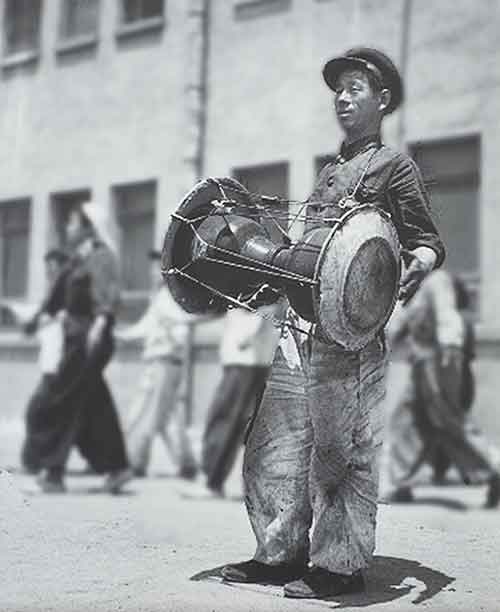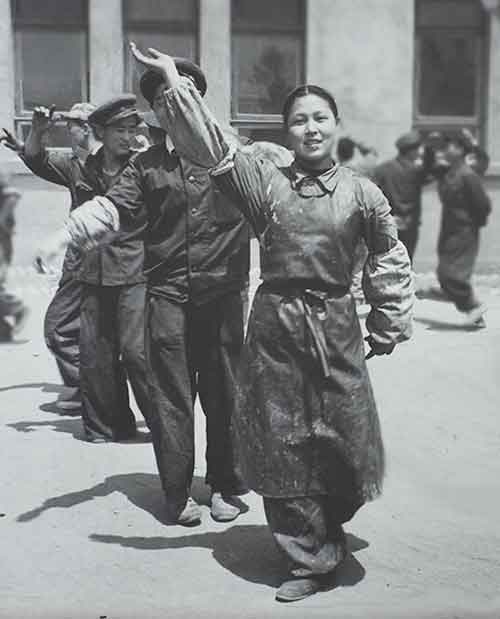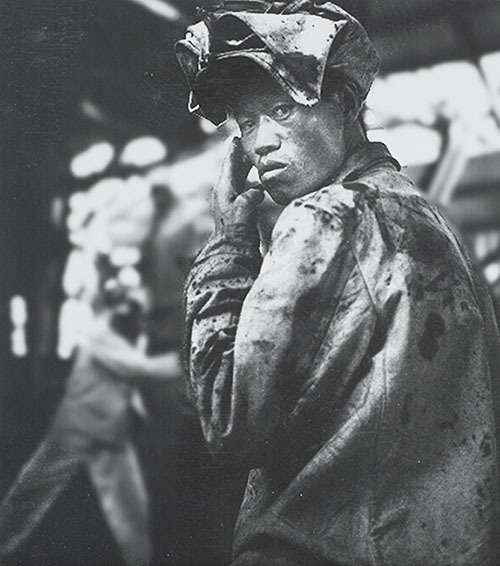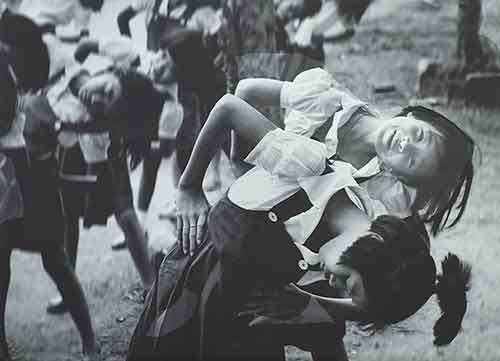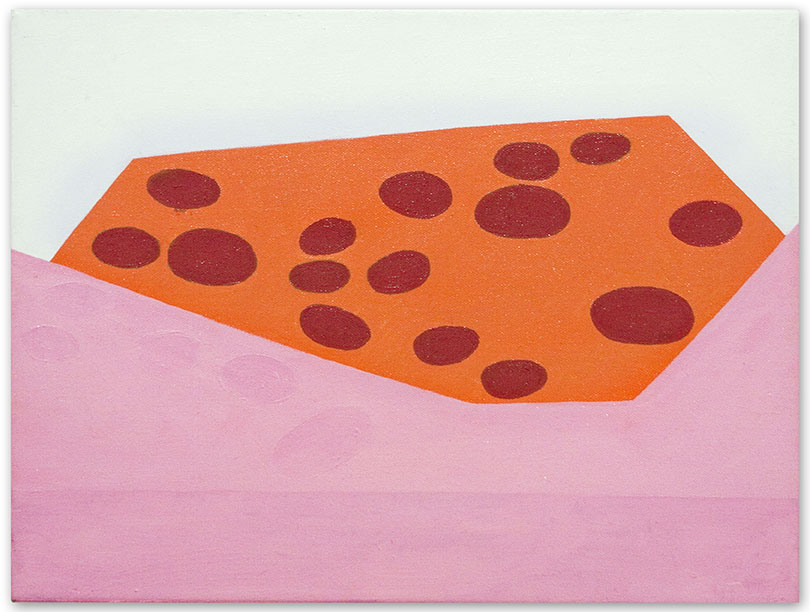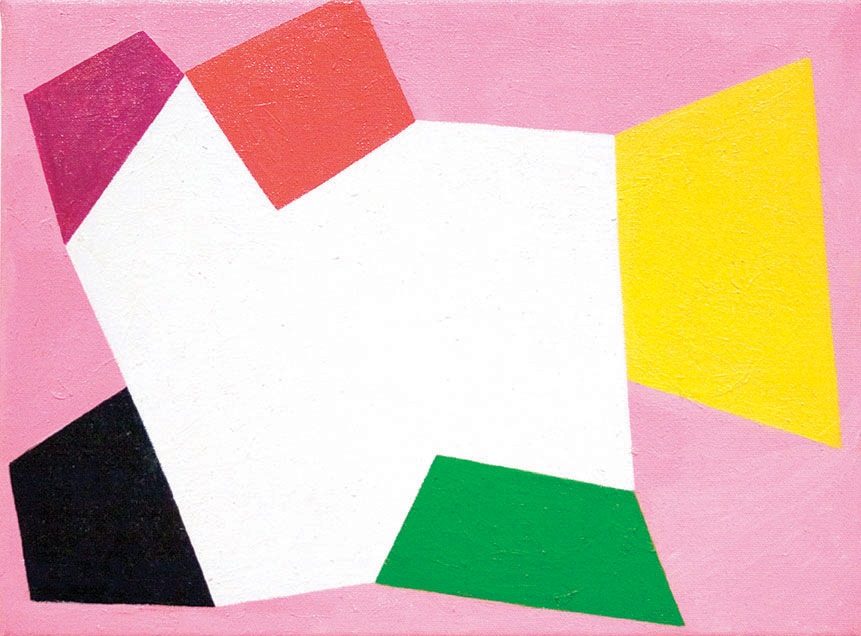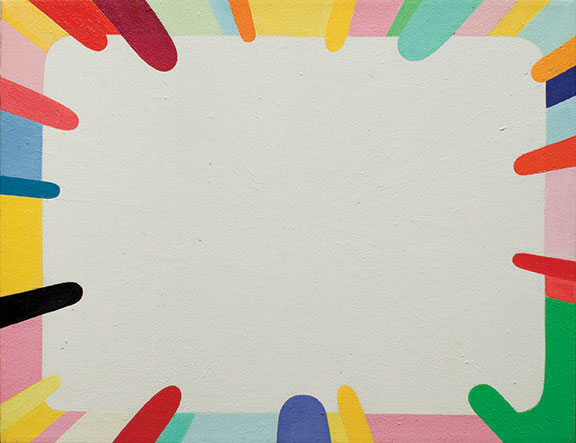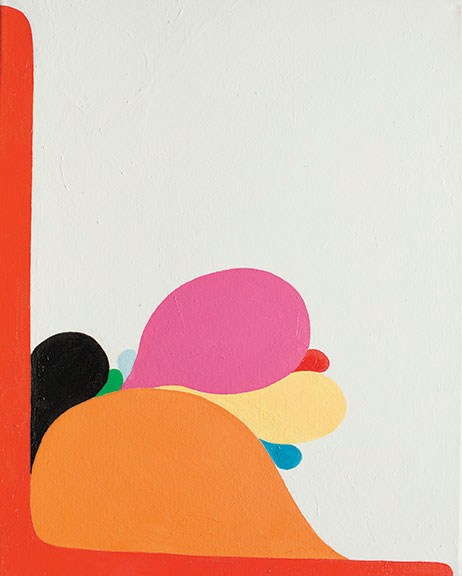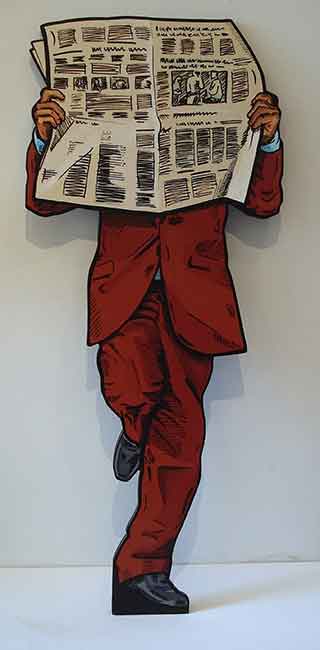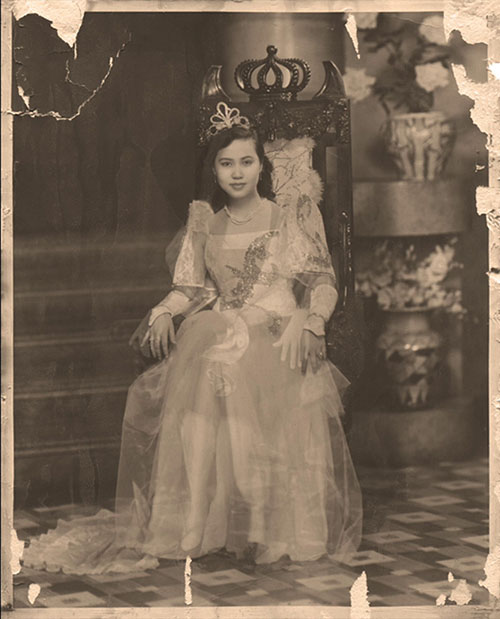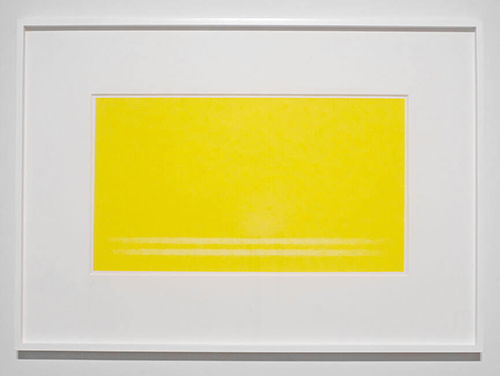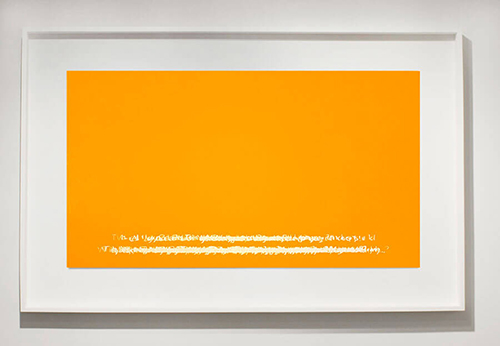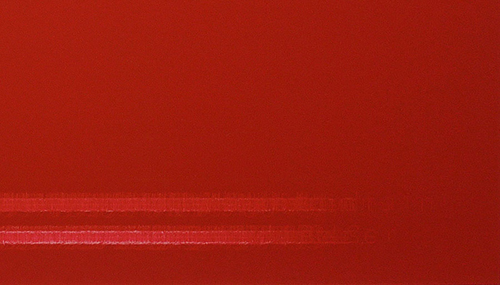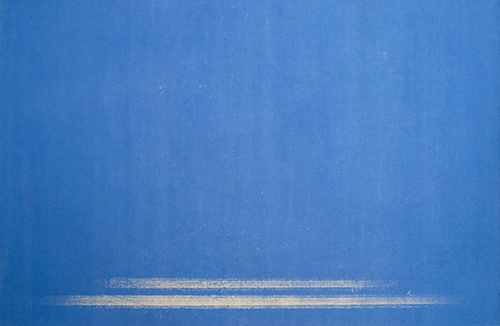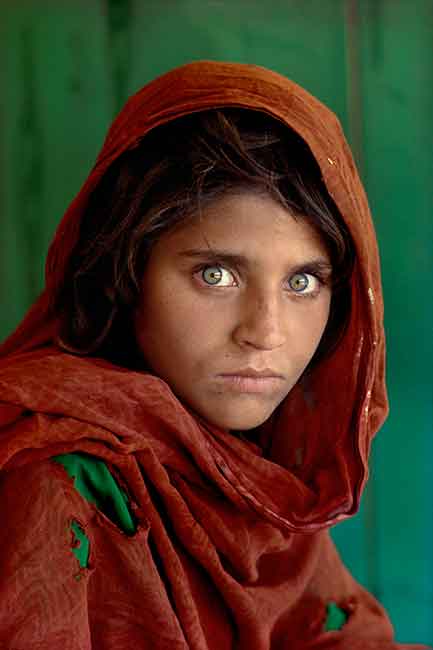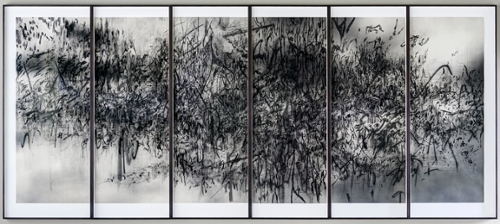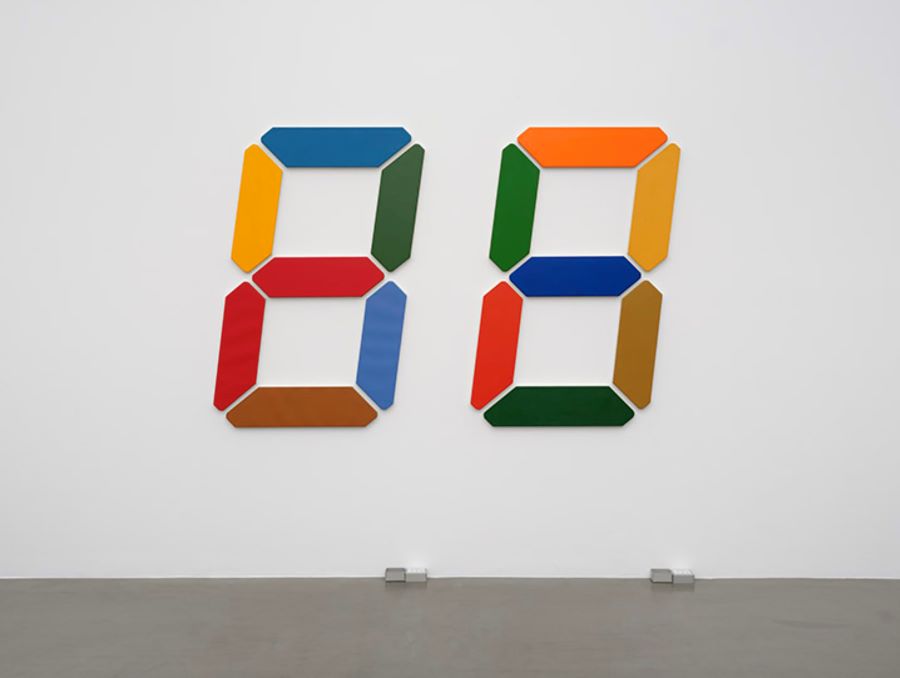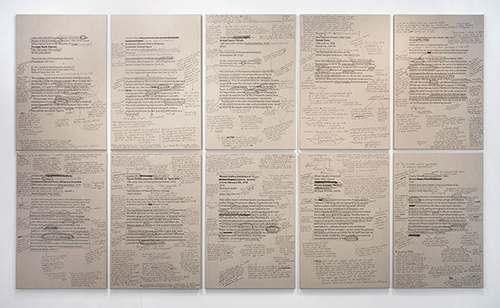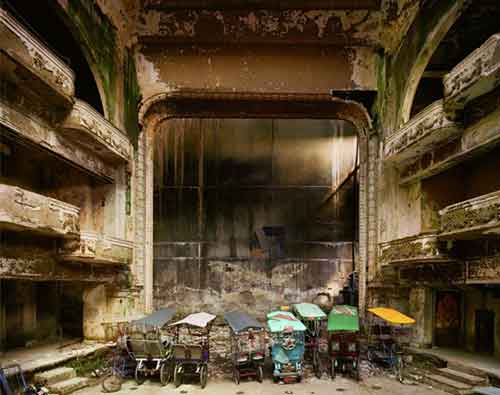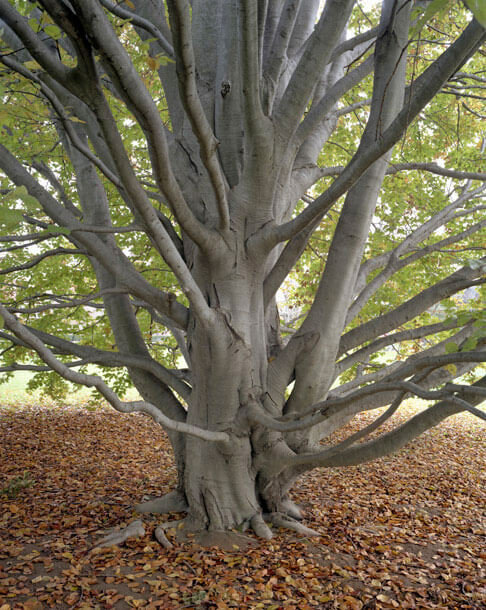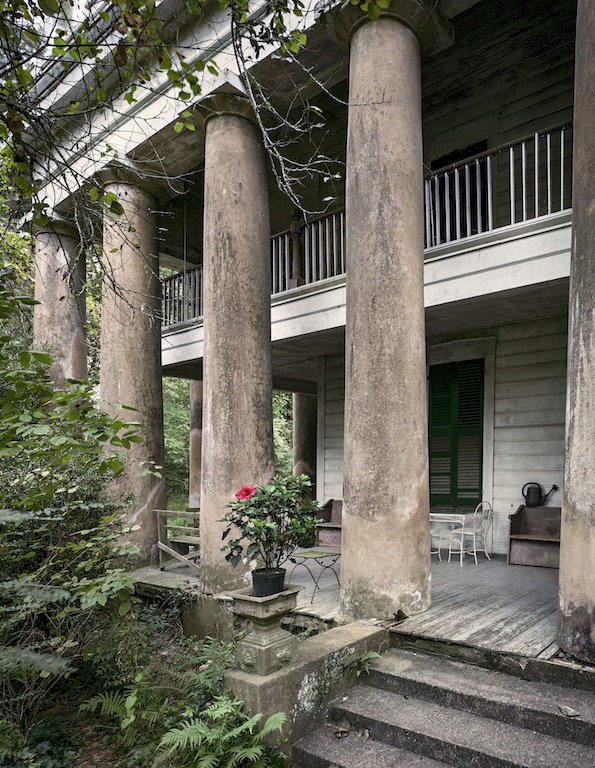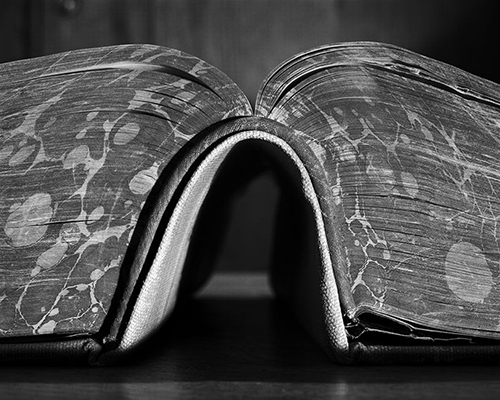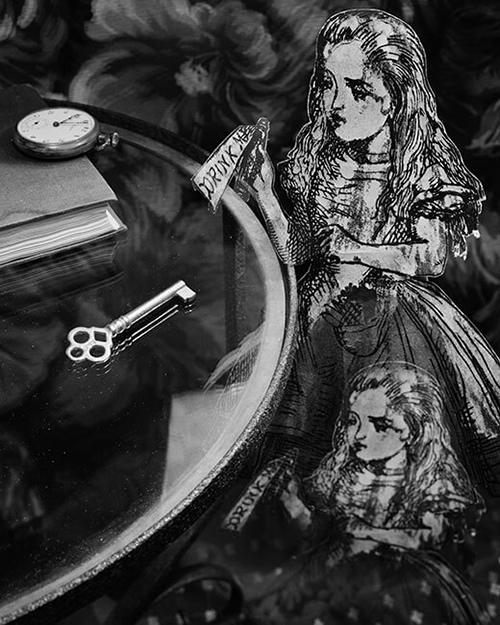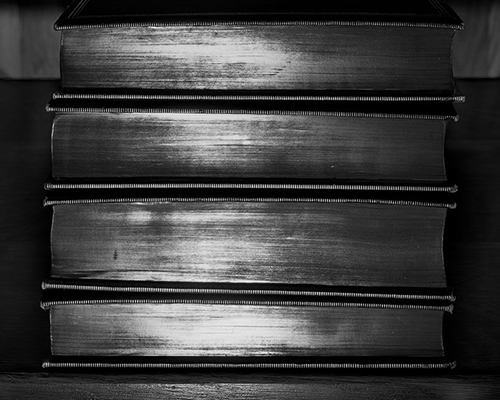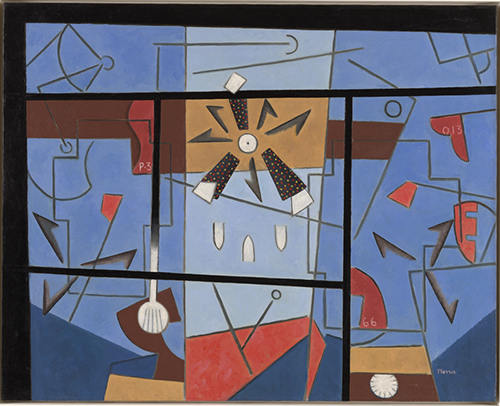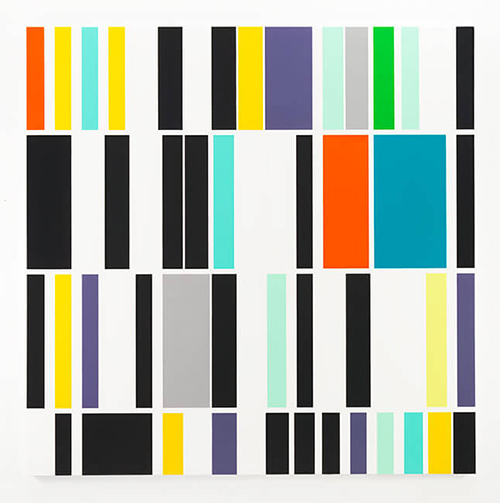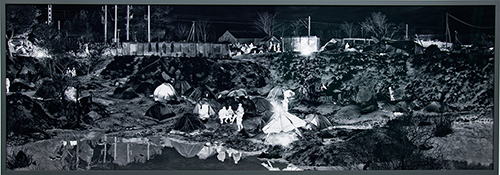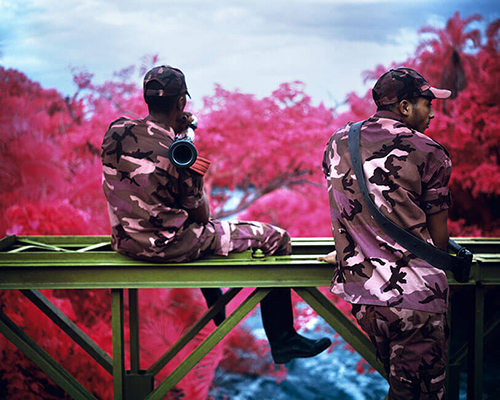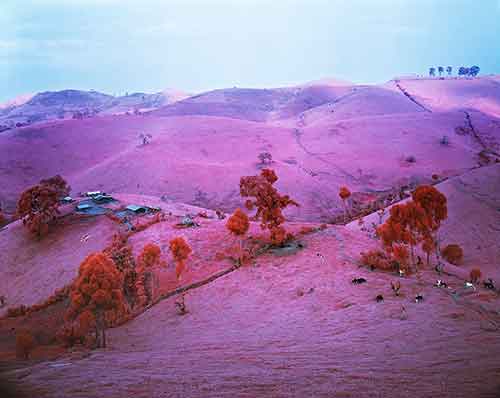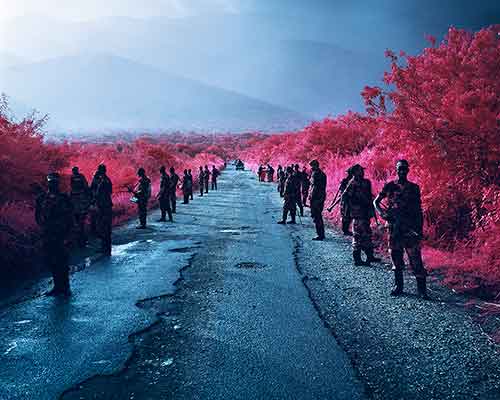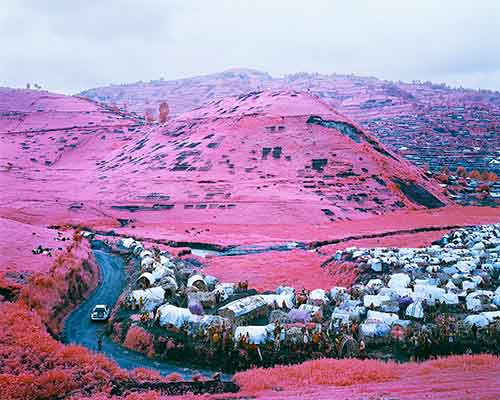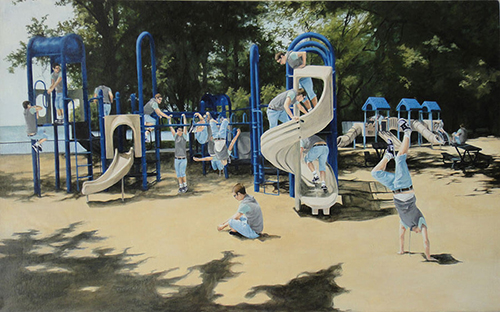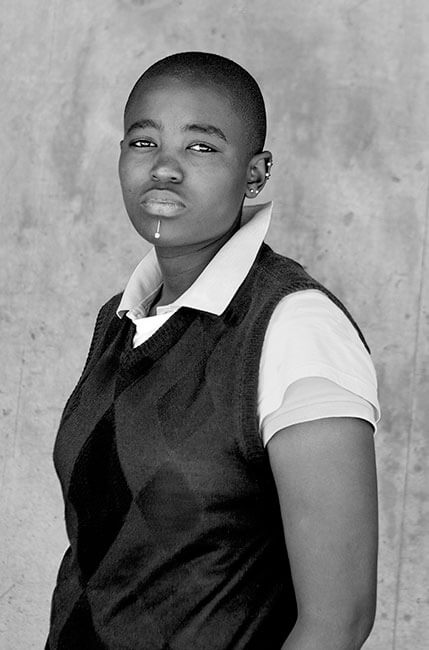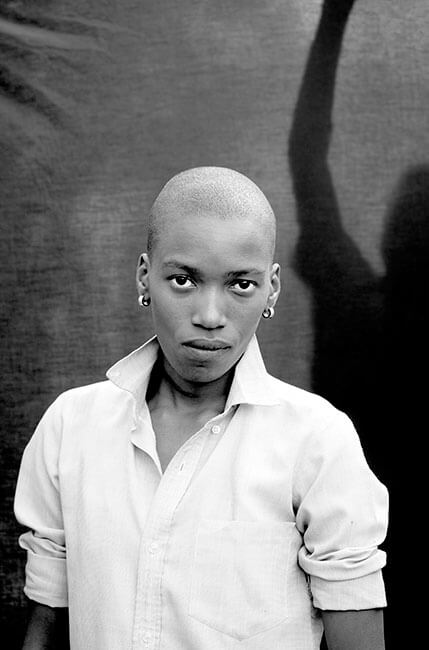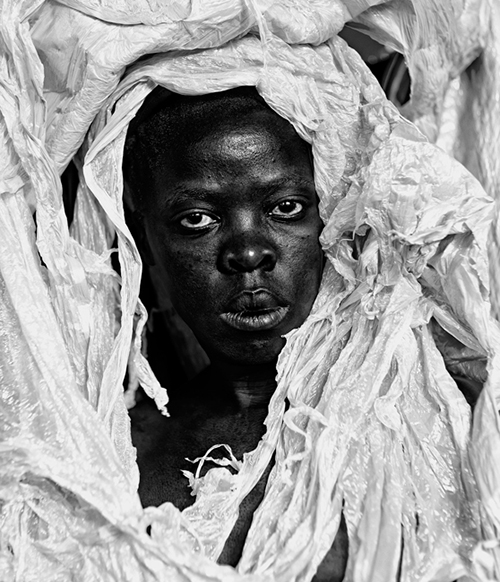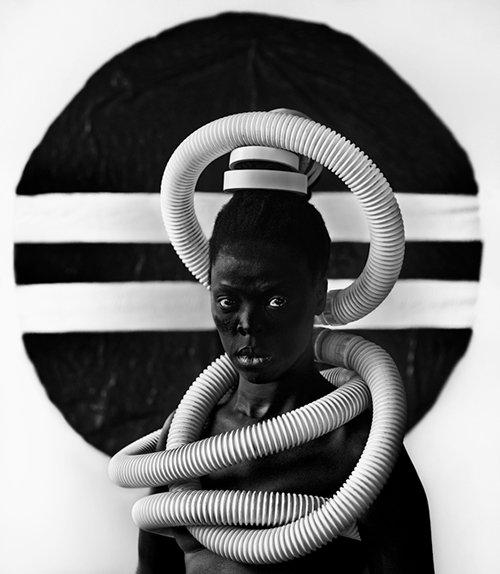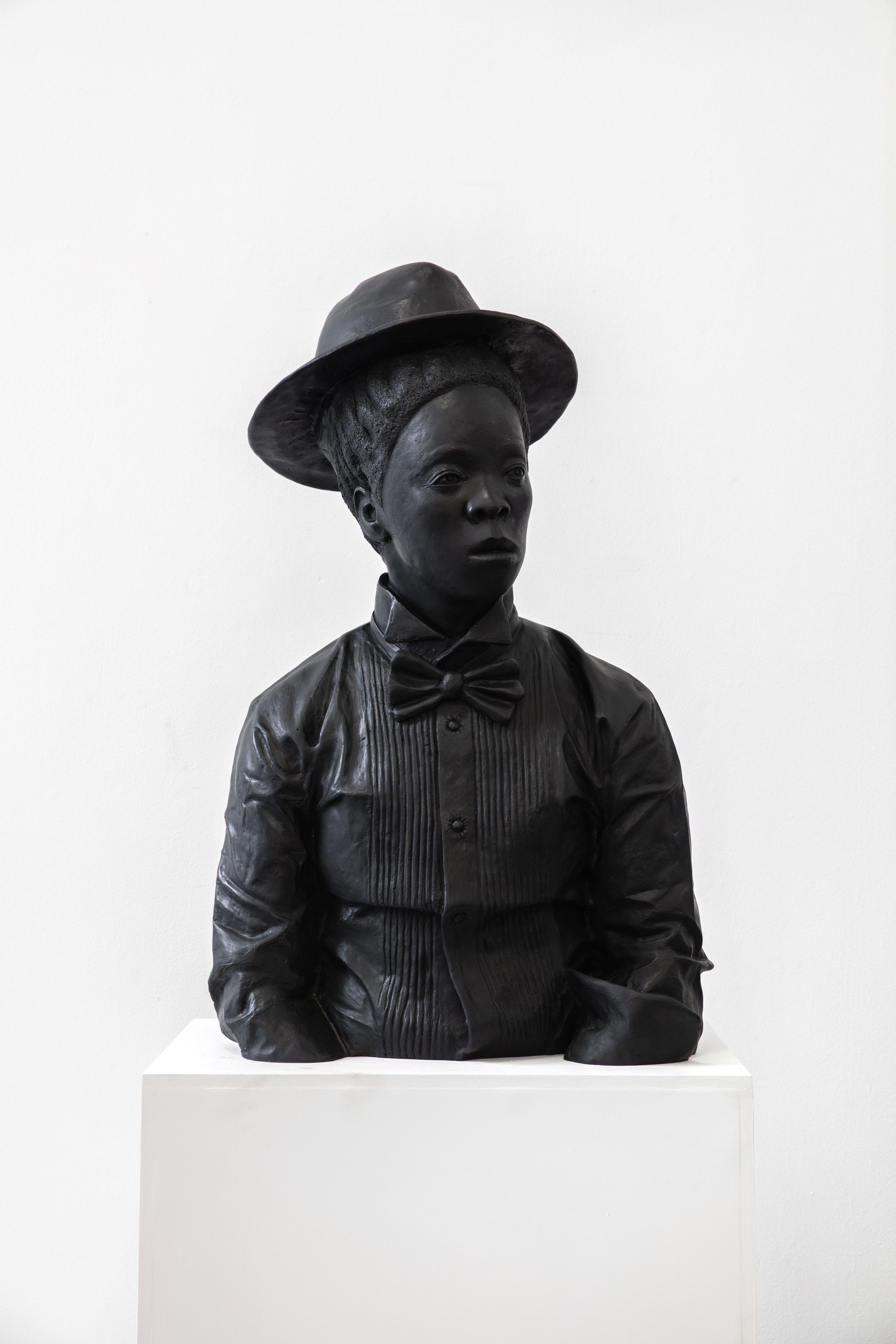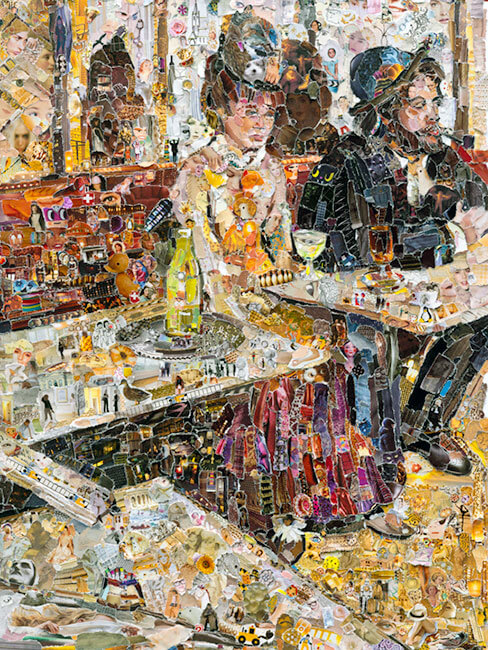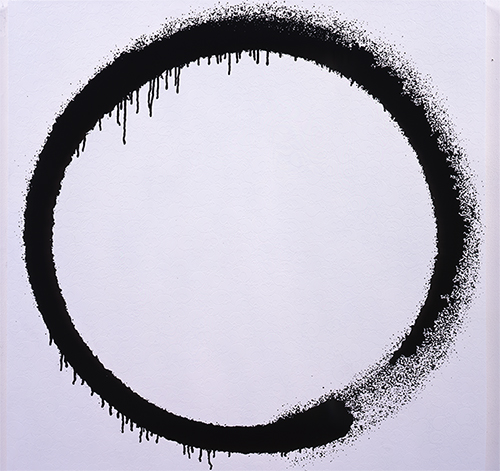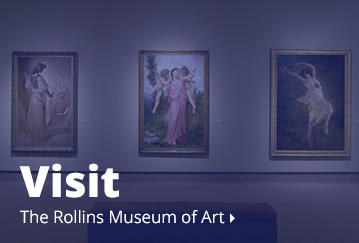Alfond Collection: Artists M
From Neeta Madahar to Vik Muniz, explore the works of artists M in the Alfond Collection of Contemporary Art.
PLEASE NOTE: Not all works in the Rollins Museum collection are on view at any given time. View our Exhibitions page to see what's on view now. If you have questions about a specific work, please call 407-646-2526 prior to visiting.
Artists Featured in This Section
Neeta Madahar
(British, b. 1966)Falling 2, 2005
Lightjet print face mounted on plexiglas
30 x 30 in.
The Alfond Collection of Contemporary Art, Gift of Barbara '68 and Theodore '68 Alfond, 2013.34.56. Image courtesy of the artist and Howard Yezerski Gallery.
Neeta Madahar’s Falling 2 (2005) appears astoundingly simple. Sycamore seeds drop mysteriously out of a cloudy sky. Gazing at their twirling forms evokes a feeling of weightlessness, transporting the viewer into a state of reverie. Falling 2 offers a buoyant moment, a memory experience of the uncomplicated joy and sweet pleasure of childhood.
But do things ever fall quite so gracefully? Marcel Duchamp’s Three Standard Stoppages (1913-1914), where lengths of string dropped from a height of one meter with the resulting swoop recorded, turned out to be a lie. Strings inevitably tangle, just as falling seeds may clump together or be taken by the wind. Evenly distributed across the surface of the image, Madahar’s photograph is enchanting, the intensity of the detail and the fixity of the seeds making them somehow more present than life. We sense this even more so in Falling 4 (2005), which no longer has the bucolic presence of the sky to orient us. The deep black background leaves us entranced in a dark void where the seeds, crisply delineated and sharply focused, take on a more surreal quality—artificial and orchestrated.
Recognizing the constructed aspects of these images moves us from a state of innocence into a state of art. Madahar’s images are smart, and more complex than they appear. Her work suggests the picturesque, a term first used to describe 18th-century landscape paintings. Artists at that time sought to find in nature the means to make a good picture, reversing the relationship between nature and art. Rather than copying nature, art would improve upon it. Other of Madahar’s works more overtly address the role of the artist’s hand in generating what appears to be a natural phenomenon. In her Cosmoses series, painstakingly folded origami flowers are scattered in a pleasing arrangement. The word “cosmos” aptly refers to both to an ornamental plant of the daisy family and an idea of the universe as a well-ordered whole. Madahar’s practice similarly reconciles grand schema with detailed particularities, and her careful constructions make it possible for us to see the universe in a flower, or the beauty and randomness of nature in a tumbling seed.
--Kelly Presutti
Neeta Madahar
(British, b. 1966)Falling 4, 2005
Lightjet print face mounted on plexiglas
30 x 30 in.
The Alfond Collection of Contemporary Art, Gift of Barbara '68 and Theodore '68 Alfond, 2013.34.57. Image courtesy of the artist and Howard Yezerski Gallery.
Tala Madani
(Iranian American, b. 1981)Projections, 2015
Oil on linen
80 x 98 1/4 x 1 3/8 in.
The Alfond Collection of Contemporary Art, Gift of Barbara '68 and Theodore '68 Alfond, 2016.3.8. Image courtesy of the artist and Pilar Corrias Gallery, London. Photo: Josh White.
Born in Tehran, Iran and raised in the United States, Tala Madani integrates her knowledge of both Middle Eastern and Western culture into her works. Projections depicts a group of the artist’s signature nude male figures sitting, kneeling, and reclining in submissive positions. The six figures are situated in an indeterminate, dark space, illuminated only by the harsh beams of light that project eerie smiley faces onto the men’s bodies. Madani explained that she was “thinking about the idea of light and power or control through light.” The artist explores gendered power dynamics through her work which places the dominant male figure in the passive and sexualized poses historically reserved for women in artistic representation.
Troy Makaza
(Zimbabwean, b. 1994)Big Man Syndrome, Part 2, 2021
Silicone infused with pigment
94 1/2 x 64 5/8 in.
The Alfond Collection of Contemporary Art, Rollins Museum of Art, Gift of Barbara ’68 and Theodore ’68 Alfond, 2021.1.33
Born in Zimbabwe in 1994, Troy Makaza currently lives and works in Harare. In his work, the artist examines social, cultural, and political issues in contemporary Zimbabwean society. Referencing the enduring dominance of the patriarchy and the detrimental consequences of colonial social structures, Makaza’s Big Man Syndrome engages with gender and social politics. His wall pieces blur the boundaries between traditional definitions of painting and sculpture; they explore and reinvent forms and textures that incorporate weaves and braid patterns, silicone and other materials. For the artist, the engagement with the materials is as important as the content of the piece: “This medium allows me to move between sculpture and painting and to disrupt categories set up by people who are not us, so in a way it is me asserting my right as an artist to determine how I am seen and not allow myself or my content to be categorized.”
Teresa Margolles
(Mexican, b. 1963)El Brillo: One assassination shapes the world (Un asesinato forma el mundo), 2020
Garment hand-embroidered in goldwork bullion style with glass shards from a site where violent acts occurred in Culiacán, Sinaloa, Mexico, 2019, 24k gold thread, bullion, tulle, display form
59 ½ x 23 x 13 in.
The Alfond Collection of Contemporary Art, Gift of Barbara ’68 and Theodore ’68 Alfond. 2020.1.6 ©Teresa Margolles
Born and raised in Mexico, Teresa Margolles was trained as a forensic pathologist and worked as a mortician in Mexico City in the 1990s. Her work addresses the social aspects of tragedy and the aftermath of violence and loss. Often graphic, Margolles’ past works investigate images of death and brutality. Although less obvious, her recent series entitled El Brillo consists of a collection of garments that incorporate in their creation material traces of violence. For the creation of this elegant bullion style embroidered piece, the artist used glass fragments she collected from crime scenes in Mexico as well as across the border in places like El Paso, Texas. By hand-stitching the glass fragments to high fashion garments created by New York based designers, Margolles connects the violence in Mexico to the U.S border since often these crimes are committed with U.S. manufactured weapons and ammunition. The garments in this series give victims of such crimes a voice and expose the realities existing on both sides of the border.
Chris Marker
(French, 1921-2012)Koreans, Untitled #12, 1957
Black and white digital photograph mounted on black Sintra
9 1/2 x 13 7/8 in.
The Alfond Collection of Contemporary Art, Rollins Museum of Art, Gift of Barbara '68 and Theodore '68 Alfond, 2014.1.56. Image courtesy of the artist, the Chris Marker Estate, and Peter Blum Gallery, New York.
There is an intimacy to French filmmaker Chris Marker’s photographs that we rarely associate with North Korea. The country is so shrouded in propaganda, so closed to our gaze, that an image as simple as schoolgirls exercising, as in Koreans, Untitled #46, becomes utterly exceptional. Marker started his career as a journalist, and it was in this capacity that he was able to enter North Korea in 1957, just four years after the Korean War. In his own words, this was a time when “the formidable propaganda machine that would soon be identified with the sheer mention of North Korea wasn’t yet running at full throttle,” meaning he was able to travel freely and capture a degree of everydayness that has not been visible for many years.
These photographs were originally included in a photo-text album published in French and Korean, Coréennes (1959). Marker’s written essay for the volume wanders through Korean mythology and contemporary observations; through it we get a strange, impressionistic vision of the place, complemented by his images. In Koreans, Untitled #35, Marker documents the hope characteristic of that moment, of the imagined possibility for a future that did not, ultimately, materialize. It is a scene of workers, dressed in the uniform of the proletariat, dancing in a courtyard, offering a glimmer of Karl Marx’s workers’ paradise, and the potential Marker saw for a communism that might avoid the pitfalls of the Soviet Union.
While the photographs do not appear as explicitly political images, they support Marker’s view of politics as a matter of understanding. He attempts to promote this understanding through portraiture, primarily through faces, as if seeing into the eyes of others might truly allow us to know them and their situation. Yet for all the closeness of these images, something remains unreachable. The young mother in Koreans, Untitled #22, with her baby swaddled behind her, gazes enigmatically past us to something outside the frame. Marker shows us North Korea but refuses us the facile assumption that we could ever grasp the complexity of the country through a series of photographs; his images thrive in this paradox of closeness and distance.
--Kelly Presutti
Chris Marker
(French, 1921-2012)Koreans, Untitled #22, 1957
Black and white digital photograph on mounted on black Sintra
13 7/8 x 9 1/2 in
The Alfond Collection of Contemporary Art, Rollins Museum of Art. Gift of Barbara '68 and Theodore '68 Alfond, 2014.1.55. Image courtesy of the artist, the Chris Marker Estate, and Peter Blum Gallery, New York.
Chris Marker
(French, 1921-2012)Koreans, Untitled #34, 1957
Black and white digital photograph on mounted black Sintra
13 7/8 x 11 3/8
The Alfond Collection of Contemporary Art, Rollins Museum of Art. Gift of Barbara '68 and Theodore '68 Alfond, 2014.1.57. Image courtesy of The Chris Marker Estate and Peter Blum Gallery, New York.
Chris Marker
(French, 1921-2012)Koreans, Untitled #35, 1957
Black and white digital photograph on mounted on black Sintra
13 7/8 x 11 1/4 in
The Alfond Collection of Contemporary Art, Rollins Museum of Art. Gift of Barbara '68 and Theodore '68 Alfond, 2014.1.53. Image courtesy of the artist, the Chris Marker Estate, and Peter Blum Gallery, New York.
Chris Marker
(French, 1921-2012)Koreans, Untitled #41, 1957
Black and white digital photograph on mounted on black Sintra
13 7/8 x 12 1/4 in
The Alfond Collection of Contemporary Art, Rollins Museum of Art. Gift of Barbara '68 and Theodore '68 Alfond, 2014.1.56. Image courtesy of the The Chris Marker Estate and Peter Blum Gallery, New York.
Chris Marker
(French, 1921-2012)Koreans, Untitled #46, 1957
Black and white digital photograph on mounted black Sintra
10 1/8 x 13 7/8 in.
The Alfond Collection of Contemporary Art, Rollins Museum of Art. Gift of Barbara '68 and Theodore '68 Alfond, 2014.1.52. Image courtesy of The Chris Marker Estate and Peter Blum Gallery, New York.
Andrew Masullo
(American, b. 1957)Untitled (4469), 2005
Oil on Canvas
12 x 16 in.
The Alfond Collection of Contemporary Art, Gift of Barbara '68 and Theodore '68 Alfond, 2013.34.113. Image courtesy of the artist and Steven Zevitas Gallery, Boston, MA.
Anti-conceptual in his outlook, Andrew Masullo considers his work nonobjective as opposed to abstract––his paintings are not reductions of anything, but presentations of pure composition and color. To construct his vivacious, color-rich surfaces, he applies layers of unmixed oil paint to store-bought canvases of conventional sizes. He does not include subject matter or imagery in any traditional sense, eschewing any information that would interfere with his focus: his practice concerns only the process and satisfaction of painting itself.
Masullo typically uses a small-to-medium-size format to suit his preference of working with the canvas on his lap or leaning against a wall. Each painting is identified by a number in lieu of a title. He tirelessly reconsiders his paintings––and though the colors of previous iterations do not read through repainted areas, remnants of brushstrokes and impasto dollops testify to his patient reworking of simple elements to create a more satisfying whole.
Masullo’s installations assert the interconnectivity of his forms. During exhibitions, works hang in concert, constellations of canvases of varying sizes that seem to talk to one another. Masullo majored in Languages at Rutgers University; ironically, the absence of textual or literary references in his practice creates a new kind of vocabulary, serving a visual rather than verbal mode of communication. From painting to painting, Masullo revisits particular palettes and gestures, and the repetition inevitably signals his priorities. For instance, the Pepto-Bismol pink color recurs as foreground for a white void with color-blocked flaps, as cushion for an orange and red polka-dotted shape, and as the base of an angled horizon and a collection of small rectangular and square forms. Repetition forges recognition.
Despite working within substantial self-imposed limits, within each canvas Masullo finds freedom and opens up space. Energy courses through his paintings, making as a clear an argument as any that communication comes in many forms that have nothing to do with words.
--Abigail Ross Goodman
Andrew Masullo
(American, b. 1957)Untitled (4546), 2006
Oil on canvas
12 x 16 in.
The Alfond Collection of Contemporary Art, Gift of Barbara '68 and Theodore '68 Alfond, 2013.34.104. Image courtesy of the artist and Steven Zevitas Gallery, Boston, MA.
Andrew Masullo
(American, b. 1957)Untitled (5001), 2008
Oil on canvas
14 x 18 in.
The Alfond Collection of Contemporary Art, Gift of Barbara '68 and Theodore '68 Alfond, 2013.34.105. Image courtesy of the artist and Steven Zevitas Gallery, Boston, MA.
Andrew Masullo
(American, b. 1957)Untitled (5157), 2009–2010
Oil on canvas
24 x 20 in.
The Alfond Collection of Contemporary Art, Gift of Barbara '68 and Theodore '68 Alfond, 2013.34.108. Image courtesy of the artist and Steven Zevitas Gallery, Boston, MA.
Andrew Masullo
(American, b. 1957)Untitled (5260), 2010–2011
Oil on canvas
20 x 16 in.
The Alfond Collection of Contemporary Art, Gift of Barbara '68 and Theodore '68 Alfond, 2013.34.110. Image courtesy of the artist and Steven Zevitas Gallery, Boston, MA.
Adam Matak
(Canadian, b. 1977)Red Reader, 2010
Acrylic and graffiti marker on plywood
62 x 24 in.
The Alfond Collection of Contemporary Art, Gift of Barbara '68 and Theodore '68 Alfond, 2016.3.5. © Adam Matak. Image courtesy of the artist.
Annu Palakunnathu Matthew
(British, b. 1964)To Majority Minority, 2014-15
Digital Animation on iPad
19 1/2 x 15 in.
The Alfond Collection of Contemporary Art, Gift of Barbara ‘68 and Theodore ‘68 Alfond, 2018.1.8. Image courtesy of the artist and SepiaEYE, New York
Annu Palakunnathu Matthew considers herself a global citizen. Having resided in England, India, and the U.S., her work often conveys the struggles of ‘aliens’ —immigrants who are seen as ‘Others.’ In this video, Matthew uses digital animation to blend together photographs of multiple generations of women from immigrant families, creating the sense that they are reaching out to understand each other. One family, a mother and daughter from the Philippines, reflects on the early stages of their migration. Like many American families, they fought over chores and took inspiration from American media. By telling their story, Matthew highlights a common humanity between ‘us’ and ‘them,’ focusing on the push-and-pull that occurs in every mother-daughter relationship.
Stefana McClure
(Irish, b. 1959)Breaking the Waves: closed captions to a film by Lars von Trier, 2002
Wax transfer paper mounted on rag paper
32 x 50 in.
The Alfond Collection of Contemporary Art, Gift of Barbara '68 and Theodore '68 Alfond, 2013.34.69. Image courtesy of the artist and Josée Bienvenu Gallery, New York.
When Walter Benjamin wrote in 1936 about the growing popular interest in film, he noted that the medium generated a condition of distraction, precluding attention to any one detail in particular. Swept along with its temporal flow, viewers’ attention is directed by a film, their vision zooming in and out and turning with the camera. In her series Films on Paper, Stefana McClure reclaims the ability to direct her own gaze, and focuses on what is supposed to be a film’s least visible element––the subtitles. On a single rectangular, monochromatic surface that evokes the theater screen, McClure meticulously traces all of a film’s subtitles. The result is a blur, but a blur that contains within it the content of an entire movie. Normally seen as a troublesome if necessary distraction from the film itself, here the text is the central element of the composition, in effect replacing a work with its supplement.
--Kelly Presutti
Stefana McClure
(Irish, b. 1959)Gold Rush: closed captions to a film by Charles Chaplin, 2012
Yellow transfer paper mounted on rag paper
23 x 32 19/32 in.
The Alfond Collection of Contemporary Art, Gift of Barbara '68 and Theodore '68 Alfond, 2013.34.70. Image courtesy of the artist and Josée Bienvenu Gallery, New York.
Stefana McClure
(Irish, b. 1959)Peel: English subtitles to a film by Jane Campion, 2010
Orange transfer paper mounted on dibond paper
9 45/64 x 16 in.
The Alfond Collection of Contemporary Art, Gift of Barbara '68 and Theodore '68 Alfond, 2013.34.66. Image courtesy of the artist and Josée Bienvenu Gallery, New York.
Stefana McClure
(Irish, b. 1959)Roshomon: English subtitles to a film by Akira Kurosawa, 2011
Wax transfer paper mounted on dibond paper
39 x 60 in.
The Alfond Collection of Contemporary Art, Gift of Barbara '68 and Theodore '68 Alfond, 2013.34.68. Image courtesy of the artist and Josée Bienvenu Gallery, New York.
The films McClure chooses to work with give us insight into her motivations. For Rashomon: English subtitles to a film by Akira Kurosawa (2010), she has selected a deep crimson backdrop. The film is a 1950 period drama that presents the telling and retelling of a brutal murder from a number of different perspectives: McClure’s practice of repetition and superimposition thus mirrors the original source. Rather than pinpointing a clear account of the events, the plurality of perspectives results in a complex film and, in McClure’s drawing, a visual babel.
--Kelly Presutti
Stefana McClure
(Irish, b. 1959)The Sound of Music: closed captions to a film by Robert Wise, 2008
Blue transfer paper mounted on rag paper
23 1/4 x 32 1/4 in.
The Alfond Collection of Contemporary Art, Gift of Barbara '68 and Theodore '68 Alfond, 2013.34.67. Image courtesy of the artist and Josée Bienvenu Gallery, New York.
Questions of communicability are also explored in The Sound of Music: closed captions to a film by Robert Wise (2008), whose title serves as a reminder of what we are not hearing––the music for which the film is named. Here, McClure alerts us to what is not translatable, an insight that applies to many of her visualizations of foreign-language films. Rather than assuming that the subtitles are a neutral representation of the film, McClure calls our attention to them as framing devices that mediate our experience, moving us from a state of distraction to one of inquiry.
--Kelly Presutti
Steve McCurry
(American, b. 1950)Sharbat Gula, Afghan Girl, Pakistan, 1984
C-type print on Fuji Crystal Archive Paper
24 x 20 in.
The Alfond Collection of Contemporary Art, Gift of Barbara '68 and Theodore '68 Alfond, 2013.34.93. © Steve McCurry. Image courtesy of Peter Fetterman Gallery.
In 1978 Steve McCurry quit his job as a newspaper photographer, purchasing a one-way ticket to India. By 1979 he was sneaking across the border into Afghanistan with a group of mujahideen, intent on documenting the Afghan civil war that would soon result in the Soviet invasion of the country. His images of the conflict resulted in the award of the Robert Capa Gold Medal for photographic reporting in 1980. Since then, he has become one of the country’s—and the world’s—best-known documentary photographers, specializing in particular on Afghanistan and South Asia more broadly.
In 1984 National Geographic—one of McCurry’s most consistent clients and supporters—sent him back to Afghanistan, this time to document the rapidly growing refugee camps on the Pakistani border, near Peshawar. A chance encounter with a girls’ school led him to his most famous subject, Sharbat Gula, a young Pashtun girl who was living in the camp. McCurry noticed her piercing green eyes, taking a series of photographs of her without learning her name. Only when he returned to the United States did he realize the power of the image he had captured, which was published on the cover of National Geographic’s June 1985 issue. It quickly became the magazine’s best-known and most popular cover, igniting a flurry of interest in the plight of the Afghani people. After the September 11, 2001 terrorist attacks and the subsequent invasion of Afghanistan by the United States this interest was renewed, and National Geographic sent McCurry and a film crew to attempt to identify her. They were able to find her, and McCurry took another series of photographs of the now grown-up Gula for the magazine.
Julie Mehretu
(American, b. 1970)Epigraph, Damascus, 2016
Photogravure, sugar lift aquatint, spit bite aquatint, open bite Hahnemuhel
97 1/2 x 40 3/4 x 2 3/4 in.
The Alfond Collection of Art, Rollins Museum of Art, 2016.3.17. Image courtesy of the artist and Marian Goodman Gallery
This work reveals an emphatic, intuitive choreography of brushwork let loose atop a matrix of the elegant architectural foundations of the Syrian capital city. Mehretu’s monumental, multi-process, multi-panel print must be understood through its strata. It exemplifies rich and varied printmaking techniques and a dynamic approach to mapping. The city of Damascus has endured seemingly unending violence and uncertainty over the centuries, and has been once again the site of carnage and destruction in recent years. In writing on a related series, Mehretu’s The Grey Paintings, fellow artist Glenn Ligon describes an aspect of her practice as painting “traversed by history.” Mehretu bears witness through this work and other recent efforts to a multitude of periods—from the most ancient through to the Arab Spring and beyond. On top of the precise drawings of arches and columns, her gestural marks evoke a thundering storm, cosmic chaos, and an extraordinarily lyrical crescendo.
Jason Middlebrook
(American, b. 1966)Wall Space, 2015
Acrylic on Maple
17 x 17 1/2 in.
The Alfond Collection of Contemporary Art, Gift of Barbara '68 and Theodore '68 Alfond, 2015.1.15. Image courtesy the artist and Morgan Lehman Gallery.
Tyler Mitchell
(American, b. 1995)Swoosh, 2021
Dye sublimation on fabric
62 ½ x 50 in.
The Alfond Collection of Contemporary Art, Gift of Barbara ’68 and Theodore ’68 Alfond, 2021.1.17 © Tyler Mitchell
Unable to return to Georgia while working in New York during the COVID-19 pandemic, Tyler Mitchell reflected on perceptions of home and their relation to blackness. Once able to return home, Mitchell created images for his series, Dreaming in Real Time, evoking scenes of black leisure within nature, but also questioning ideals of black refuge in the American South. Swoosh portrays a black boy wearing dark pants captured from the waist down. His face obscured by the billowing fabric on a clothesline, the imagery implies an absence of self. Through the prominent use of red checkered fabric, Mitchell references the practice of redlining in the south, ultimately causing numerous inequalities for black communities. The fabric also implies the domestic space of working black people through visual similarities to hanging laundry. In displaying the work on fabric, Swoosh mirrors the fabric within the composition, establishing a complex visual narrative that considers black bodies and their surroundings.
Tatsuo Miyajima
(Japanese, b. 1957)Painting of Change - 016, 2021
Oil on canvas, 2 dice, wooden bar
59 x 92 3/8 x 1 1/4 in.
The Alfond Collection of Contemporary Art, Rollins Museum of Art. Gift of Barbara ’68 and Theodore ’68 Alfond, 2022.2.4 © Tatsuo Miyajima
Time, continuity, and the belief that everything exists in a constant state of flux are key principles in Tatsuo Miyajima’s art. Born in Japan in 1957, Miyajima is one of the country’s most prominent sculptors and installation artists. His work engages with the notion of impermanence by exploring technology, repetition, sequences, and Buddhist teachings. For the artist, the universality of numbers, in concept and in form, allows his message to transcend cultural barriers. Chance is for him a determining factor in the experience of the work: “In this work, I dared to leave fate to chance, hoping that people would actually experience this unpredictable world and think about what time is and what nature is.” Although Miyajima often employs technological devices to activate his works, in this case, the piece is activated by an individual who rolls the polyhedron dice to determine the number that will be displayed.
To avoid excessive manipulation of this work of art, a trained museum art handler reconfigures its component parts to reflect the number indicated by a roll of the dice once every week.
Meleko Mokgosi
(Motswana, b. 1981)Modern Art: The Root of African Savages, 2013
Inkjet and charcoal on linen
10 panels: 36 x 24 in. each
The Alfond Collection of Contemporary Art, Gift of Barbara '68 and Theodore '68 Alfond, 2013.34.54.1-4. Image courtesy of the artist and Honor Fraser Gallery. Photo credit: Farzad Owrang.
Meleko Mokgosi is perhaps best known for making large paintings and collages that imitate grand narrative, or history paintings, in subject matter and form. Yet Mokgosi’s paintings have gaping blanks in which objects, interiors, or natural surroundings are not described. In presenting narrative paintings that are simultaneously readable and unreadable, Mokgosi seems to suggest that some histories are only partially told or understood, pointing to the limits of representation and the ongoing complications of cultural translation. In particular, Mokgosi seeks to confront the issues of conflict and crisis in post-colonial Africa—from Botswana to Sudan to Zimbabwe—and to address the slippery notion of nationalism in the aftermath of colonialism and in the midst of financial and informational globalization.
At the Armory Show 2013, Meleko Mokgosi unveiled a new series of text-based paintings, Modern Art: The Root of African Savages. He took the descriptive wall labels from the exhibition African Art, New York, and the Avant-Garde at the Metropolitan Museum of Art (November 27-September 2, 2013), enlarged them to 36 x 24 inches, and printed them onto linen panels. Thus, the typical 6- x 4-inch wall label that accompanies an artwork on exhibition becomes the size of a typical portrait painting. The formal structure of the letters, numbers, punctuation, and spacing on the labels provides the groundwork for the artist’s elaboration. Mokgosi annotates the label text in charcoal, crossing out and circling words, inserting question marks and arrows, and adding editorial remarks and marginalia to highlight the inaccuracies, absences, distortions, and deletions in the Eurocentric art-historical narrative of the influence of “African” art on modernist artists in Europe and the United States. In this new series, Mokgosi’s emphatic textual comments and erasures are linked formally and conceptually to the detailed imagery and significant blanks in his grand narrative paintings.
Although this art-historical narrative—that “African” art is a “savage” or “primitive” form of expression—has been reexamined and redressed in recent scholarship and museum exhibitions, Mokgosi’s paintings starkly reveal its lingering pervasiveness. His handwritten comments suggest the deeper implications of assigning to a particular artwork an artist attribution, country of origin, and provenance, let alone an essentializing description. Mokgosi intertwines his comments with quotes from different disciplines and sources to engage with, and alter the terms of, the art-historical narrative and to bring the viewer’s attention to the continuing problems inherent in the exhibition of “African” works of art.
--Alison J. Hatcher
Andrew Moore
(American, b. 1957)Campo Amor (Vista Este), Havana, Cuba, 1999
Archival Pigment Print
3 x 65 in.
The Alfond Collection of Contemporary Art, Gift of Barbara '68 and Theodore '68 Alfond, 2016.3.6. © Andrew Moore. Image courtesy of the artist and Yancey Richardson Gallery.
Andrew Moore
(American, b. 1957)European Beech, Vassar College, 2007
Chromogenic print, 1 of 15
68 x 56 1/2 in.
The Alfond Collection of Contemporary Art, Gift of Barbara '68 and Theodore '68 Alfond, 2013.34.118. © Andrew Moore. Image Courtesy of the artist and Yancey Richardson Gallery.
Since the late 1970s, Andrew Moore has used the chromogenic process to powerful effect in his exploration of both urban and natural landscapes. With a precise and artistic eye, he creates riveting documentary images of the architecture that defines a cityscape and, often, the trees that cohabit with them. His urban series––whether from Detroit, Cuba, or Russia, or elsewhere––chronicle the ephemerality of the edifices and emblems of civilized society that are constructed by man. For Moore, trees represent the opposite; they are markers of resilience and endurance. He explains that the trees he has captured in his lens “contain and summarize, as it were, the history of the land that [they] grew upon.”
European Beech, Vassar College (2007) forms part of a commissioned series on the specimen trees of the Vassar College campus. The tree’s trunk stands tall, its branches envelop the viewer, and its roots sink deeply into the ground to firmly establish and celebrate its permanence. Inclusion of this work in the Alfond Collection invites viewers—often stakeholders in Rollins College—to view Moore’s European Beech, Vassar College in the ideal context of the college campus. Here, the beech tree functions as a totem, recalling the role of the university as a place where the young become educated, where their lives begin to branch out into new roles and directions, and where the new ideas that flower may also remain deeply rooted.
--Maria C. Taft
Andrew Moore
(American, b. 1957)Pitts' Folly, Perry County, AL, 2016
Archival pigment print
60 x 50 in.
The Alfond Collection of Contemporary Art, Gift of Barbara '68 and Theodore '68 Alfond, 2018.1.20. © Andrew Moore
Andrew Moore
(American, b. 1957)School District 123, Cherry County, Nebraska, from the series Dirt Meridian, 2013
Archival pigment print
40 x 50 in.
The Alfond Collection of Contemporary Art, Gift of Barbara '68 and Theodore '68 Alfond, 2013.34.147. © Andrew Moore. Image courtesy of the artist and Yancey Richardson Gallery.
Andrew Moore poignantly captures sublime scenes of desolation and dilapidation in his monumental photographs. Moore has produced several photographic series that focus on various sites with connotations of economic depression and architectural dilapidation in places such as Cuba, Russia, Detroit, and the American West. School District 123, Cherry County NE is part of the latter series, Dirt Meridian (2005–present). The title of the series refers to the 100th meridian west, which is the longitudinal line that is generally considered the dividing line between the American East and West. Running through North and South Dakota, Nebraska, Kansas, Oklahoma, and Texas, the area is scarcely inhabited due to hostile weather conditions and bleak agricultural potential.
This segment of the United States’ geography has been mythologized by canonical works in art history: the sublime geological survey photography of nineteenth-century artists such as William Henry Jackson, Timothy O’Sullivan, and Carleton Watkins beckoned American settlers west, while modern artists like Walker Evans and Dorothea Lange captured the devastating reality of life in the Dust Bowl during the Great Depression. Moore’s twenty-first–century photographs of the so-called “dirt meridian” take up both of these legacies in equal measure, capturing the awesome nature of the vast landscape and the people and infrastructure that struggle to exist within it.
While many of the works in the series are vast aerial landscapes, captured by the artist via a digital camera mounted to an airplane, other works, such as School District 123, are made from large-format negatives taken of isolated places sought by the artist on foot. Shot inside a small schoolhouse that once served the children of a ranching community, the photograph captures a blackboard filled with scribbles—strikingly similar to a Cy Twombly canvas—surrounded by cracking plaster and peeling paint. In many ways, this tableau can be viewed as a metaphor for the greater landscape without: it is expansive, and a small population has assertively imprinted on its surface. Though the marks have slowly faded with the passing of time, and the earliest impressions have been negated by the overlaid inscriptions of generations that followed, the blackboard palimpsest ultimately attests “we were here.” Moore’s photograph preserves this assertion of identity as an indelible mark made by the people of the dirt meridian.
--Samantha Cataldo
Andrew Moore
(American, b. 1957)Whiskey Point, East Kingston, 2022
archival pigment print
40 x 50 in.
The Alfond Collection of Contemporary Art, Rollins Museum of Art. Gift Barbara '68 and Theodore '68 Alfond, 2024.1.3. © Andrew Moore, Courtesy of the artist and Yancey Richardson, New York
In this photograph, artist Andrew Moore depicts a site along the Hudson River that has "renatured" after facing environmental degradation caused by industrial development in the 19th and early 20th centuries. The painter captured in this photograph embodies the longstanding pictorial tradition of observing the sublime in the American landscape, dating back to artists like Thomas Cole. Yet there is a bitter irony in realizing that the painter is standing on land forever changed by human enterprise.
Like artist Andrew Moore, Rollins Professor of Social Entrepreneurship Dr. Walter Mswaka strives for a new generational outlook on the historic consequences of business upon nature. Dr. Mswaka is dedicated to developing future business leaders who are conscientious about their connected economic and environmental impacts. He shares, "My teaching focuses on producing a new generation of students who place the wellbeing of the world and societies at the core of what they do." To achieve this, Dr. Mswaka utilizes a curriculum founded on case studies and experiential learning--challenging students to ethically address current real-world issues.
Andrew Moore
(American, b. 1957)Betty Lou Hill, Milan, 2021
chromogenic print
40 x 50 in.
The Alfond Collection of Contemporary Art, Rollins Museum of Art. Gift Barbara '68 and Theodore '68 Alfond, 2024.1.4 © Andrew Moore, Courtesy of the artist and Yancey Richardson, New York
Abelardo Morell
(American, b. 1948)Open Dictionary, 2001
Archival pigment print
50 x 60 in.
The Alfond Collection of Contemporary Art, Gift of Barbara '68 and Theodore '68 Alfond, 2013.34.7. Image courtesy of the artist and Carroll and Sons, Boston.
Morell’s Shiny Books (2000) exemplifies this group. The shimmering edges of countless pages within a pile of books become modern sculpture in the legacy of Donald Judd’s “stacks.” In Open Dictionary (2001), Morell presents the spine of an open tome. The resulting shape resembles a mysterious mountain tunnel cutting through mounds of stone.
--Al Miner
Abelardo Morell
(American, b. 1948)Children's Book, 1987
Archival pigment print
30 x 40 in.
The Alfond Collection of Contemporary Art, Gift of Barbara '68 and Theodore '68 Alfond, 2013.34.8. Image courtesy of the artist and Carroll and Sons, Boston.
Abelardo Morell, who spent his childhood in Cuba—a place that time and progress forgot—is known for embracing historical photographic techniques. His works romanticize the pre-digital age in both their method and imagery, rendering the ordinary extraordinary without manipulation.
His photographs of the 1990s, taken with a camera obscura, put Morell on the map. One of the earliest forms of photography, a camera obscura isn't a camera at all by current standards, it's architecture. All the light is removed from a room by covering every window except for a small hole through which exterior light can enter. Morell sets up his film camera in the room and takes long exposures of the image, an inverse of the external scenery, which floods in through the opening. (Now, however, Morell works strictly with a camera.)
Morell’s respect for photography’s roots is particularly evident in his black and white work. While some photographers eagerly await every new advance in digital technology, others like Morell look backward, saving early photographic techniques from extinction and remaining enthralled by the mechanics of film cameras. Another photographer of note, Sally Mann has revived and deeply investigated the potential of antique bellows cameras and wet plate negative processes.
In our modern world in which words are so often read on screens, Morell celebrates the analog objecthood of the book. This subject is apt, as he also shuns the digital intervention of Photoshop and does not even crop his images. Furthermore, Morell had to learn English at the age of 14, which perhaps made him appreciate both words and books as aesthetic forms. In fact, observing sunlight on these beloved objects sparked a series of duotone images.
In these images and others, Morell harnesses traditional photographic techniques to elevate books—objects that bring as much knowledge and pleasure to readers as Morell’s work does to viewers.
--Al Miner
Abelardo Morell
(American, b. 1948)Drink Me, 1998
Archival pigment print
40 x 30 in.
The Alfond Collection of Contemporary Art, Gift of Barbara '68 and Theodore '68 Alfond, 2013.34.6. Image courtesy of the artist and Carroll and Sons, Boston.
Abelardo Morell
(American, b. 1948)Shiny Books, 2000
Archival pigment print
50 x 60 in.
The Alfond Collection of Contemporary Art, Gift of Barbara '68 and Theodore '68 Alfond, 2013.34.9. Image courtesy of the artist and Carroll and Sons, Boston.
George L. K. Morris
(American, 1905-1975)Precision Bombing, 1944
Oil on canvas
27 x 33 in.
The Alfond Collection of Art, Gift of Barbara ’68 and Theodore ’68 Alfond, 2017.15.4. © Frelinghuysen Morris House & Studio Lenox, Massachusetts.
George L.K. Morris—along with Albert Eugene Gallatin, Suzy Frelinghuysen, and Charles G. Shaw—formed part of a group called the Park Avenue Cubists. This mildly pejorative name, given to denote the quartet’s wealthy and patrician backgrounds (Morris counted as an ancestor a signer of the Declaration of Independence), but belied the seriousness with which they took painting, in particular abstract art. Morris was a co-founder and champion of the American Abstract Artists, a loosely affiliated growth founded in 1936 to advocate in favor of abstract art during an era when the American art world was dominated by Regionalism and other figurative styles. In his painting as well as his public advocacy, Morris was a staunch supporter of a hard-edged cubism derived from that of Fernand Léger, with whom he had studied in Paris. A prominent figure in the New York art world of the 1930s and early 1940s, he and his colleagues’ cubist-derived abstraction was overshadowed by the rise of the Abstract Expressionists after World War II.
This painting dates from an interesting moment in Morris’s career. Like other leftists associated with the Popular Front, Morris considered the threat of Nazi Germany to be sufficiently urgent that he abandoned his suspicion of the military. Endeavoring to receive an appointment as a combat artist or artist-correspondent, the painter abandoned his customary complete abstraction in order to execute a series of works explicitly depicting military subjects. Morris had no military experience, instead basing these works on newspaper reports of combat. Though his attempt to join the war effort was unsuccessful, Precision Bombing is an interesting combination of his cubist abstraction with the needs of wartime representation. Particularly notable are the red sections, highlighted with the sort of numbering which would have appeared on airplane fuselages. The work’s combination of fractured picture plane and orderly grid likewise evokes the simultaneous disorder and regimentation of combat.
Sarah Morris
(American, b. 1967)Maison de France, 2013
Household gloss on canvas
84 1/4 x 84 1/4 in.
The Alfond Collection of Contemporary Art, Gift of Barbara '68 and Theodore '68 Alfond, 2013.34.148. Image courtesy of the artist and Parallax and Petzel, New York. Photo credit: Christopher Burke.
Working simultaneously in paint, public installations, and video, British American artist Sarah Morris proposes complex analogies between ideological and physical structures. She demonstrates that urban architecture is composed not only of concrete, metal, and glass, but also of intangible concepts including capitalism, power, and control. The probing eye of her camera lens aims to uncover these subliminal messages by documenting cycles of demolition, rebuilding, and gentrification in Beijing, Los Angeles, Rio de Janeiro, and other major capitals. Morris also highlights the rhetoric encoded in the built environment by mounting murals of bright, interlocking geometric shapes that interrupt the gray monotones of the metropolis. For example, Robert Towne (2006), supported by the Public Art Fund, temporarily adorned the ground-level ceiling of the Lever House in New York. This strategic placement encouraged pedestrians to break with their typical viewing patterns and redirect their attention to the upper registers of the city skyline.
The hard-edged abstractions of Robert Towne reflect Morris’s signature painting style, exemplified by Maison de France [Rio] (2013) in the Alfond Collection of Contemporary Art. This grid of black, white, lavender, and citrus-colored rectangles is titled after the French consulate in Rio de Janeiro, Brazil. Morris’s modular composition echoes the building’s geometric windows, while the lively colors reflect the dynamic international exchange that the consulate represents. At the same time, the painting’s composition recalls the geometric constructivist art style prevalent when the building opened in 1956.
As a center of Rio de Janeiro’s cultural life, the landmark Maison de France houses libraries and a theater along with the embassy. Having undergone several phases of renovation in the past half-century, the building evidences Rio de Janeiro’s evolution into a contemporary city. Morris delves deeper into this narrative of progress in an accompanying film, Rio (2012), which composes a portrait of the city through footage of its streets, factories, beaches, favelas, and avant-garde architecture. Interpreted in relation to this presentation of Rio de Janeiro and its modernization, the seemingly universal and arbitrary blocks of color that comprise Maison de France [Rio] assume a highly specific historical character.
Sarah Parrish
Richard Mosse
(Irish, b. 1980)Idomeni Camp, Greece, 2016
Digital c-print on metallic paper
40 x 120 in.
The Alfond Collection of Contemporary Art, Gift of Barbara '68 and Theodore '68 Alfond, 2017.6.4. © Richard Mosse. Image courtesy of the artist and Jack Shainman Gallery, New York.
Richard Mosse
(Irish, b. 1980)Peace Attack, Virunga National Park, North Kivu, 2012
Digital C-print
28 x 35 in.
The Alfond Collection of Contemporary Art, Gift of Barbara '68 and Theodore '68 Alfond, 2014.1.36. © Richard Mosse. Image courtesy of the artist and Jack Shainman Gallery, New York.
In his series Infra and The Enclave, begun in 2009, Richard Mosse uses a specific material, military reconnaissance film, to tell a story. These works in video and photography, which depict the eastern portion of the Democratic Republic of Congo, render anything naturally green in a bold pink palette because the film, now antiquated, reads chlorophyll as pink. One can imagine its usefulness during aerial surveillance. For a military operative seeking enemy encampments in the landscape, the film would have revealed fabricated structures among the foliage. In Mosse’s photographs, the people of the Democratic Republic of Congo emerge from the bright pink hues. In his hands, this military-derived film becomes a powerful tool with which to create images in a place often ignored by international news headlines.
Mosse acknowledges the dire situation in the Democratic Republic of Congo, which has devolved into anarchy with various groups warring against one another and committing atrocities. Since 1998, nearly six million people have lost their lives in the eastern region. Mosse leverages a non-documentary aesthetic, utilizing a brilliant palette to capture his viewers’ attention and direct it to the crisis. Moreover, references to popular songs in his titles further distance his work from documentary practice. For example, Thousands Are Sailing comes from the title of a 1988 song by the Pogues, and Safe from Harm derives from the 1991 song by Massive Attack.
Earlier in his career, the artist depicted American soldiers occupying the former palaces of Saddam Hussein’s family in Iraq, but he does not consider himself a photojournalist. In fact, he views the communicative power of photojournalism as ineffective. Instead, Mosse was drawn to create work in the Democratic Republic of Congo for reasons inherent to his artistic medium as well as by more personal motives. He saw in the contrast between the ongoing violent conflict in the region and its lush green vegetation a dramatic setting for the use of reconnaissance film. Earlier in Mosse’s life, when a friend’s father was killed in the Congo during a U.N. peacekeeping mission, the place had piqued his interest. For Mosse, the use of black-and-white photography to depict conflict zones has become less impactful in our oversaturated visual culture. The jarring shock of his colors distinguishes his work and draws attention to the scenes of conflict through a contemporary point of view.
--Amy Galpin
Richard Mosse
(Irish, b. 1980)Endless Plain of Fortune, 2011
Digital c-print
40 x 60 in.
The Alfond Collection of Contemporary Art, Gift of Barbara '68 and Theodore '68 Alfond, 2014.1.37. © Richard Mosse. Image courtesy of the artist and Jack Shainman Gallery, New York, 2014.1.37
Richard Mosse
(Irish, b. 1980)First We Take Manhattan, 2012
Digital c-print
48 x 60 in.
The Alfond Collection of Contemporary Art, Gift of Barbara '68 and Theodore '68 Alfond, 2014.1.35. © Richard Mosse. Image courtesy of the artist and Jack Shainman Gallery, New York.
Richard Mosse creates work about specific people and places, but he does not consider himself a photojournalist. This photograph is part of a series the artist developed in the eastern portion of the Democratic Republic of Congo where unrest and anarchy has resulted in the death of nearly 6 million people since 1998. Mosse used a now defunct reconnaissance film that reads chlorophyll as pink. Here, the lush vegetation of the Congo becomes transformed and the landscape is at once bizarre and beautiful. The surprising palette elicits the attention of the viewer in a way that perhaps an unaltered photograph might not. Additionally, the title of the work complicates our viewing of the photograph. First We Take Manhattan takes its name from a 1975 Leonard Cohen song. In appropriating popular song titles, Mosse further distances his work from documentary practice and calls us to look closer at what is being depicted.
Richard Mosse
(Irish, b. 1980)Thousands are Sailing 1, 2012
Digital c-print
40 x 50 in.
The Alfond Collection of Contemporary Art, Gift of Barbara '68 and Theodore '68 Alfond, 2014.1.34. © Richard Mosse. Image courtesy of the artist and Jack Shainman Gallery, New York.
Cobi Moules
(American, b. 1980)Untitled (Playground), 2009
Oil on canvas
16 x 26 in.
The Alfond Collection of Contemporary Art, Gift of Barbara ’68 and Theodore ’68 Alfond, 2013.34.10., Image courtesy of the artist and Carroll and Sons, Boston.
There are no fewer than sixteen versions of Cobi Moules’s young self in Untitled (Playground) (2009). Shown as a boy, about thirteen, each of the identical figures is dressed in blue jeans rolled up to the knee, black sneakers, and glasses. Moules sets these versions of himself free in a bright suburban playground. The figures span the composition, engaged with their surroundings and with each other. Some are active, others pensive, clever, funny, daring, social, or solitary. The resulting image is gently surrealistic.
Moules works primarily with self-portraiture, using traditional techniques and a realistic style. As a transgender person, he recognizes the complex and fluid nature of identity and its representation. He has tracked his transition from female to male; in works such as Untitled (Beards) (2009), he has sketched a portrait of himself as though gazing into a mirror to document how facial hair affects his appearance. With each new development––a slight goatee, an elongated moustache, a full, bushy beard––he examines his changing persona, presenting expressions that range from stern to jovial to patient to cool.
Despite the seriousness of his investigation, Moules’s painting is undeniably playful and light. Unlike the work of Cindy Sherman, who photographs herself dressed as clichéd versions of feminine stereotypes (the drunken starlet, the distraught housewife, the aging socialite), Moules is not showing what others think or expect him to be. He’s exploring what he can be, exposing the plurality of possible moods and attitudes each of us harbors within.
While Moules has created for himself a zone where he can fully be all his selves, the shadows of trees in the foreground loom forebodingly. It is as if they wanted to bring him back into the world of black and white––the singular self and its identical shadow. This tension is a reminder that in the face of pressure to conform, one can and must retain a space for self-exploration, a playground that is bright and welcoming.
--Kelly Presutti
Zanele Muholi
(South African, b. 1972)Qiniso, The Sails, Durban, 2019
Silver gelatin print
15 3/4 x 10 1/4 in.
The Alfond Collection of Contemporary Art, Gift of Barbara '68 and Theodore '68 Alfond, 2019.2.16. © Zanele Muholi. Image courtesy of the artist, Yancey Richardson, New York, and Stevenson Cape Town/Johannesburg.
Zanele Muholi
(South African, b. 1972)Sindi Shabalala, Parktown, Johannesburg, 2010
Silver gelatin print
30 x 20 in.
The Alfond Collection of Contemporary Art, Gift of Barbara '68 and Theodore '68 Alfond, 2014.1.28. © Zanele Muholi. Courtesy of the artist and Yancy Richardson Gallery.
I think it is the eyes you notice first. They burn out of their sockets. They are proud, and wounded, and true. I cannot know the story behind these eyes, but I do know this: it is impossible to look away.
The history of gay men, lesbians, and transgender people in South Africa is one of contradictions. South Africa is among the few African nations to inscribe same-sex marriage and equal rights for gender nonconforming people in its constitution. And yet, at the same time, life there is a struggle—against hatred, against ignorance, against violence. This reality belies the idealism and hope of the South African nation.
Photographer Zanele Muholi captures the truth of these contradictions as they relate specifically to trans men and lesbians. “You can’t change the laws without changing the images,” they say of their work, and it is true. My own mother used to say, “It is impossible to hate anyone whose story you know,” and, indeed, I have seen the way stories—and images—can change hearts and minds. This is the way we change the world: one image at a time.
--Jennifer Finney Boylan
Zanele Muholi
(South African, b. 1972)Makhethi Sebenzile Ndaba, Constitution Hill, Johannesburg, 2011
Silver gelatin print
30 x 20 in.
The Alfond Collection of Contemporary Art, Gift of Barbara '68 and Theodore '68 Alfond, 2014.1.29. © Zanele Muholi. Image courtesy of the artist and Yancey Richardson Gallery.
The history of lesbian, gay, bisexual, transgender, and intersex (LGBTI) individuals in South Africa is one of contradictions. South Africa is one of the few African nations to inscribe same-sex marriage and equal rights for gender nonconforming people in its constitution. Yet, at the same time, life there is a struggle against discrimination, hatred, and ignorance. Photographer Zanele Muholi uncovers the truth of these contradictions in their portraits of members from the LGBTI community. In an environment where prejudice and violence are prevalent, Muholi’s subjects assert their presence and, through steady, piercing gazes, confront their reality with a solemn strength. The close cropping around the figure further imbues the image with a fierce intensity. Muholi’s photographs not only make visible a marginalized population but also dignify its individual members.
Zanele Muholi
(South African, b. 1972)Nhlanhla Mofokeng, Katlehong, Johannesburg, 2012
Silver gelatin print
30 x 20 in.
The Alfond Collection of Contemporary Art, Gift of Barbara '68 and Theodore '68 Alfond, 2014.1.27. © Zanele Muholi. Image courtesy of the artist and Yancy Richardson Gallery.
In Nhlanhla Mofokeng, Katlehong, Johannesburg (2012), Muholi depicts a standing figure in a white shirt, eyes piercing back at us, as a shadow in the background suggests a dancing soul, one arm raised up to heaven. The contrast is unsettling—those intense, serious eyes, a figure who seems so fundamentally still, and, in the shadow the opposite, the dancing, jubilant life that for many trans men and lesbians in South Africa remains an elusive dream.
I have never thought of human eyes as gendered before, but I do now. These eyes stare back at me, asking me to open my heart. I cannot look away. So I try to look harder.
--Jennifer Finney Boylan
Zanele Muholi
(South African, b. 1972)Kwanele (Parktown), 2016
Gelatin silver
31 1/2 x 27 in.
The Alfond Collection of Contemporary Art, Gift of Barbara '68 and Theodore '68 Alfond, 2017.6.32. © Zanele Muholi. Image courtesy of the artist and Yancey Richardson Gallery, New York and Stevenson Gallery.
Zanele Muholi
(South African, b. 1972)Sebenzile (Parktown), 2016
Gelatin silver
27 1/2 x 24 in.
The Alfond Collection of Contemporary Art, Gift of Barbara '68 and Theodore '68 Alfond, 2017.6.33. © Zanele Muholi. Image courtesy of the artist and Yancey Richardson Gallery, New York and Stevenson Gallery.
Zanele Muholi
(South African, b. 1972)Muholi II, 2021
Bronze
35 7/16 x 23 5/8 x 13 25/32 in.
The Alfond Collection of Contemporary Art, Rollins Museum of Art. Gift of Barbara ’68 and Theodore ’68 Alfond. 2022.2.21 © Zanele Muholi. Courtesy Yancey Richardson, New York
In their ongoing series Somnyama, Hail the Dark Lioness, Zanele Muholi becomes the subject of their work to combat the historical erasure of Black LGBTQ+ communities. Exploring self-portraiture, this sculpture shows the artist in a dignified pose wearing a hat and bow tie. Muholi emphasizes the tone of their skin through the application of a dark patina, allowing them to reclaim their blackness and challenge culturally dominant stereotypes of Black people in the media today. The artist employs conventions of classical portraiture and fashion photography to critique “...the oppressive standards of beauty that often ignore people of color.” Born in Umlazi, South Africa, Muholi’s self-proclaimed mission is “…to rewrite a Black, queer, and trans visual history of South Africa for the world to know of our resistance and existence at the height of hate crimes in South Africa and beyond.”
Vik Muniz
(Brazilian, b. 1961)The Absinthe Drinker, after Edgar Degas (Pictures of Magazines 2), 2011
Digital c-print
96 1/2 x 71 in.
The Alfond Collection of Contemporary Art, Gift of Barbara '68 and Theodore '68 Alfond, 2013.34.101. ©Vik Muniz / Artists Rights Society (ARS), New York
Vik Muniz transforms everything from ephemera to refuse in surprising ways to create images that cleverly comment on the mechanics of perception, the relationship between material and content, and the history of art.
No substance is off limits when Muniz assembles the sculptures, drawings, and collages that he photographs. Despite the intensive sculptural process that is at the center of his practice, the resulting photographs are all that survives; documents of a fleeting image. Muniz links his material to his subjects. One of the clearest examples was the subject of a 2010 film, Waste Land, for which Muniz recycled and arranged trash to depict a community near the world’s largest garbage dump, located in his native Brazil.
Often the path from subject to artwork is less direct than in the Waste Land works. Rather than simply compose a picture himself and interpret it with aptly chosen materials, Muniz reconstructs existing content—the ubiquitous pictures of posters and publications—adding new layers of reference between subject and viewer. For instance, his portrait of Jackson Pollock in Bosco chocolate syrup, which mimics thinned paint, copies Hans Namuth’s famous photo of the artist working on one of his signature drip paintings. Here Muniz has made a picture of an artist’s photograph of an artist. This practice of appropriation places Muniz within the canon of the “Pictures Generation” photographers, American artists who came of age in the 1970s and who often directly quoted existing images.
Muniz also looks deeper into art history for inspiration. The paper collages he constructs borrow from the most recognizable and influential painters of the past, as in the case of The Absinthe Drinker, After Edgar Degas (2011). This work is a part of his Pictures of Magazines 2 series, where Muniz has torn up countless publications, harvesting images of all kinds: disembodied limbs, animals, food, porn stars, and more. Muniz’s approach of reuse opens a dialogue about recycling in our disposable culture and the visual overload of our media-saturated world. Despite the slickness of the bits of paper he uses to compose these images, he manages to convey the texture of the original paintings he quotes.
His intentionally imperfect collage references the impressionistic soft edges of the original, which depicts an artist in a café next to a woman who some claimed to be a prostitute when the painting sparked scandal in 1872. Degas was a painter of modern life, with a vocabulary newly honest and provocative for his time. Given this, one can understand what would have drawn Muniz to him—their shared interest in depicting unique characters in ways that belie the stuff of their making.
--Al Miner
Takashi Murakami
(Japanese, b. 1962)Enso: Breathing, 2017
Acrylic on Canvas mounted on aluminum frame
47.25 x 47.25 in.
The Alfond Collection of Contemporary Art, Rollins Museum of Art. Gift of Barbara '68 and Theodore '68 Alfond, 2017.6.57. © Takashi Murakami/Kaikai Kiki co., LTD. All rights reserved
Despite being known for depictions of colorful kawaii (cute) figures in his art, Takashi Murakami draws on Japanese visual traditions to reimagine Zen symbols through a contemporary lens. Murakami’s subject is Enso, or circle, representing what Zen Buddhists believe to be the perfect symbol of emptiness. If an individual attains emptiness, they are free from the cycle of rebirth, thereby resulting in a state of enlightenment. Zen masters throughout history have repeated this symbol in one spontaneous brushstroke, indicative of their heightened spiritual state. Murakami replaces this traditional spontaneity with a multistep process, integrating sketching, computer graphics, and printmaking to yield the finished product. Through close examination, the work reveals a repeating pattern of cartoon-like skulls. Skulls are another symbol of great significance in Zen Buddhism, serving as meditations on life’s impermanence. In mixing historical iconography with a contemporary sensibility, Murakami’s Enso: Breathing exemplifies a non-Western vision for contemporary art.
Elizabeth Murray
(American, 1940-2007)Flamingo, 1974-78
Oil on canvas
90 x 87 1/8 x 2 in.
The Alfond Collection of Contemporary Art, Gift of Barbara '68 and Theodore '68 Alfond, 2019.2.1. Image courtesy of the Murray-Homan Family Trust/Artists Rights Society (ARS), New York.
Elizabeth Murray earned a BFA from the School of the Art Institute of Chicago before moving to Oakland, California to study for her MFA at Mills College. She was living and working in San Francisco when she saw her first issue of Artforum, a new magazine which had emerged to combat the hegemony of ARTnews, then widely regarded as the conservative house organ of Abstract Expressionism. The issue of Artforum, which was published in San Francisco, that first captured Murray’s interest was devoted to Andy Warhol and other New York Pop artists. Thus, did a magazine explicitly designed to combat the hegemony of the New York establishment inspire a promising San Francisco artist to pick up stakes and move to New York.
By the time Murray arrived in New York the city’s art world was moving away from Pop and towards a variety of Conceptual, process-based, and other heterogenous artistic practices. Her own work for the past several years had been in three dimensions, a kind of brightly colored and whimsical version of Pop. Prompted by her exposure to Hard Edge and other post-Abstract-Expressionist painters of her generation, Murray returned to painting in oil, finding that she immediately felt at home in its familiar rhythms. Throughout the 1970s she worked with increasingly larger canvases, experimenting with often harsh juxtapositions of bright colors. Unlike most of the Hard-Edge painters, however, Murray eschewed the smooth application of rollers and airbrushes, opting instead for a thick impasto scraped only the surface with large brushes and palette knives. This—combined with her incorporation of spirals, mobius strips, and other whimsical details—lends her works of this era a painterly immediacy that would feed into her complex shaped canvases of the 1980s.

